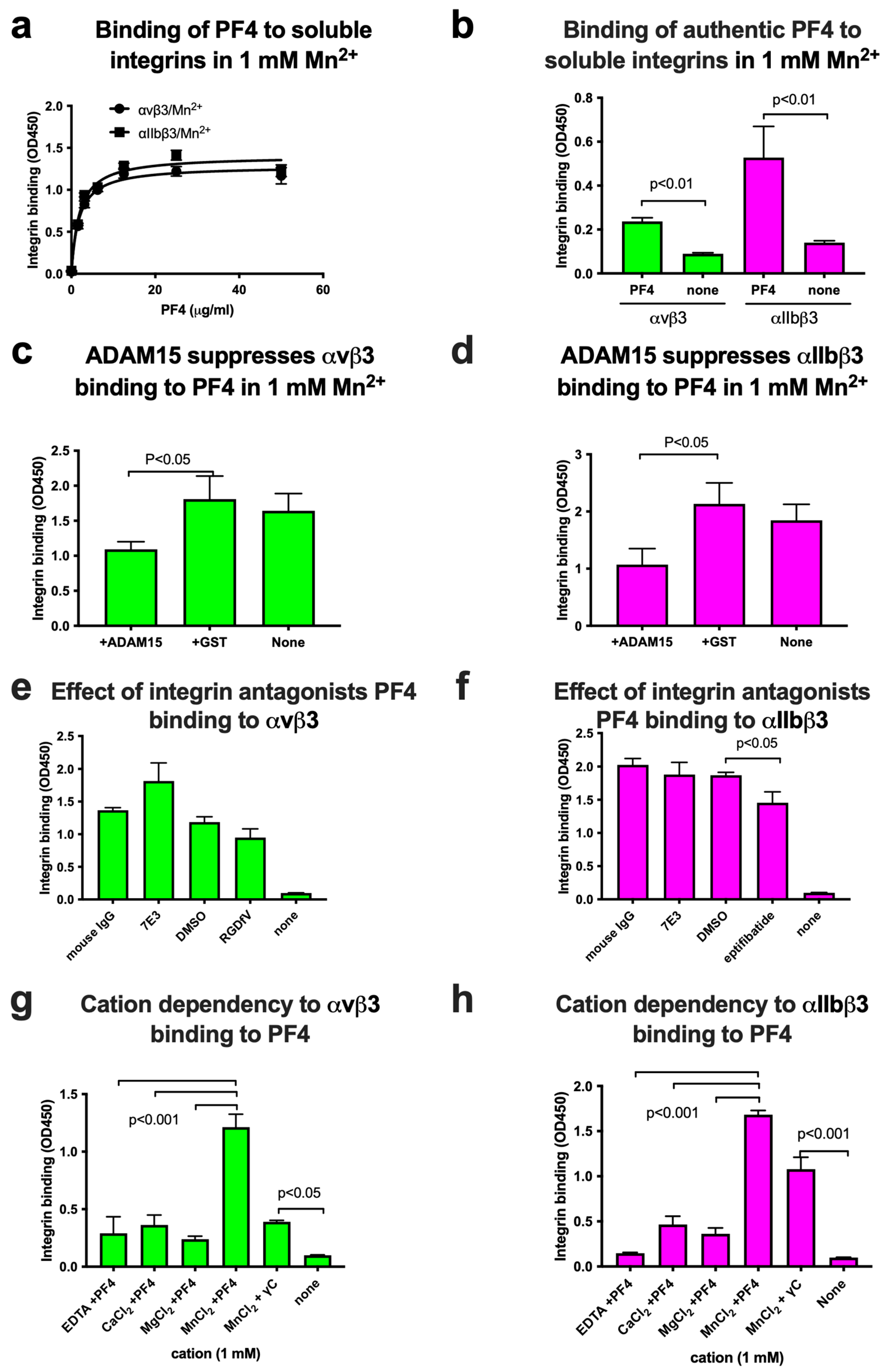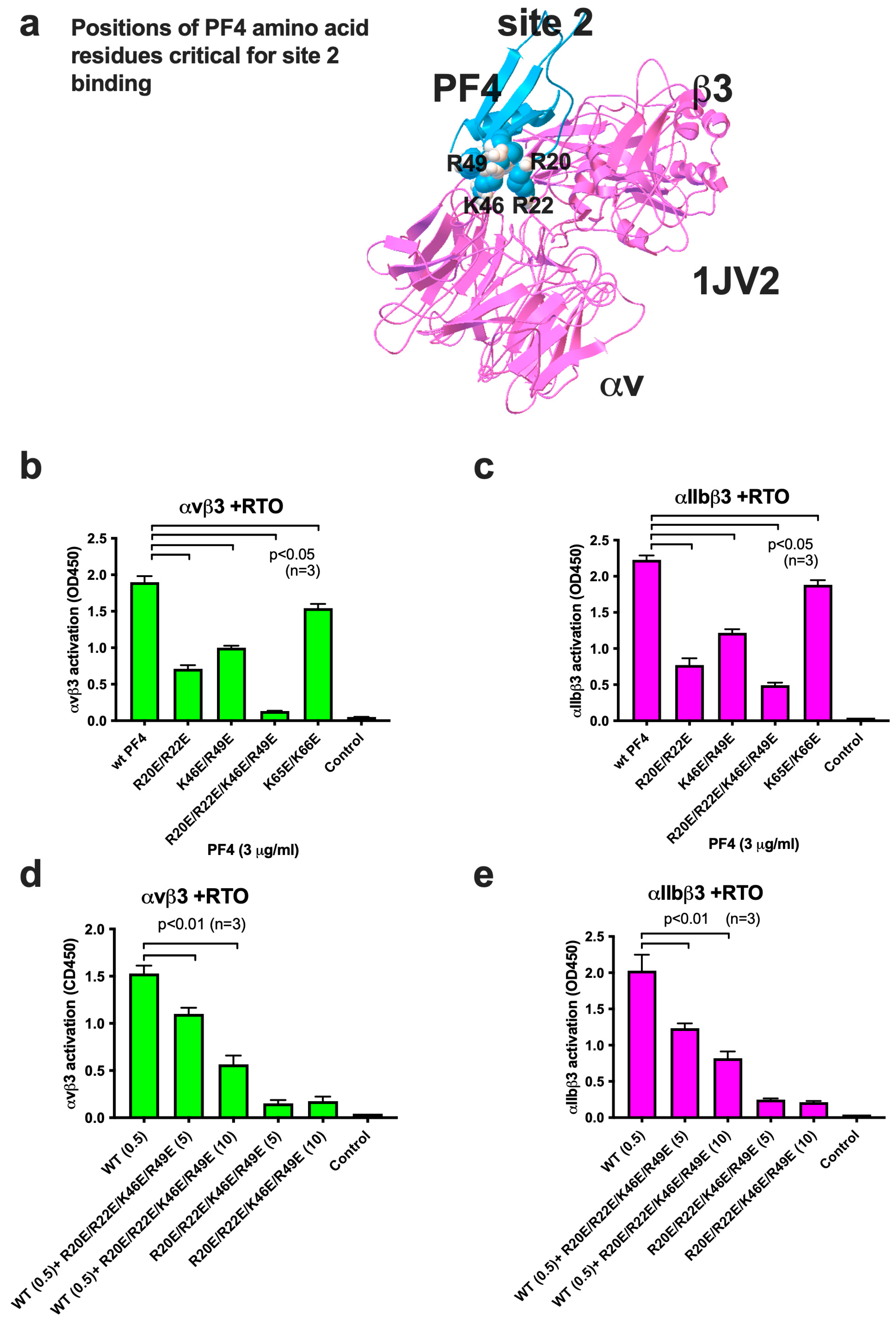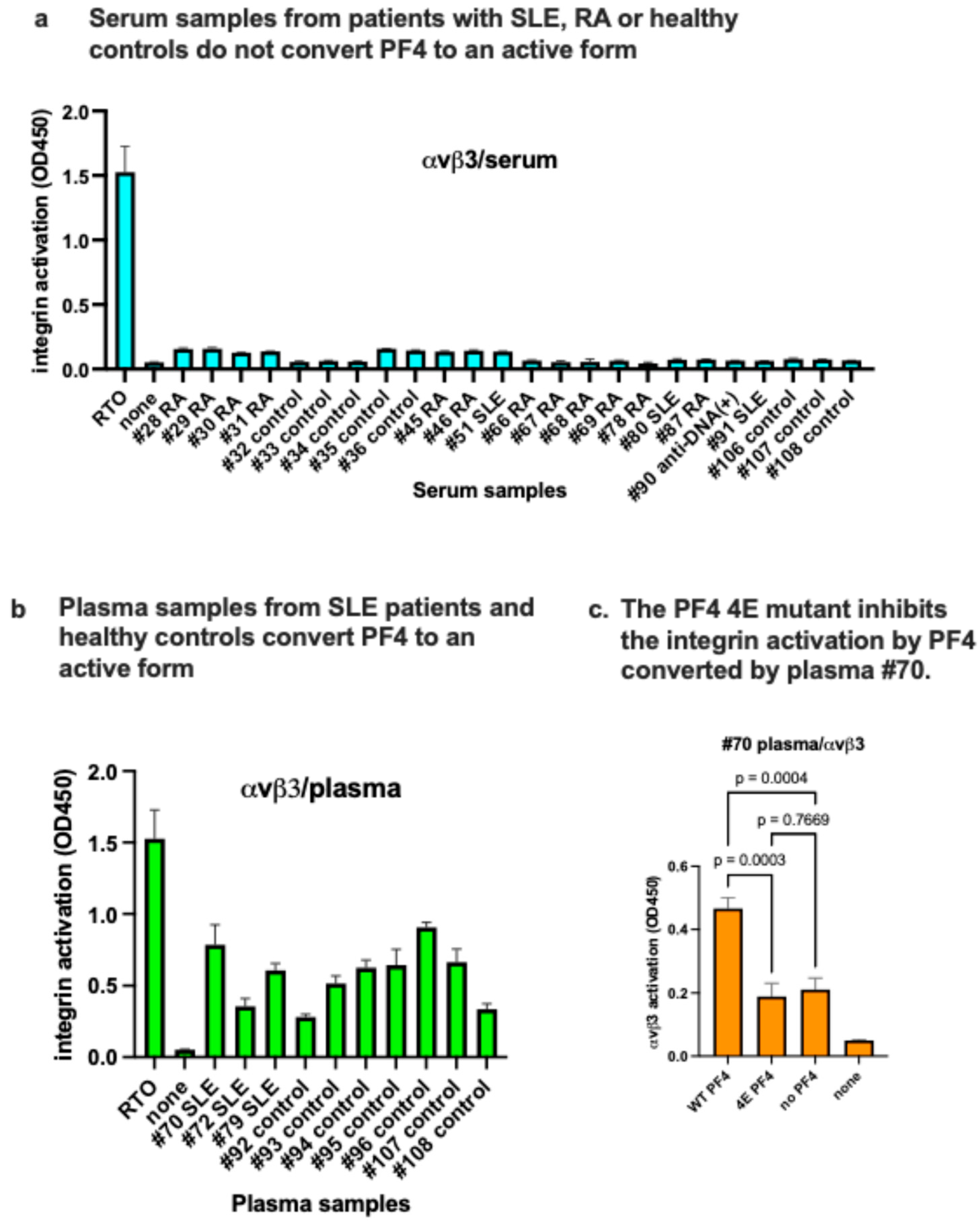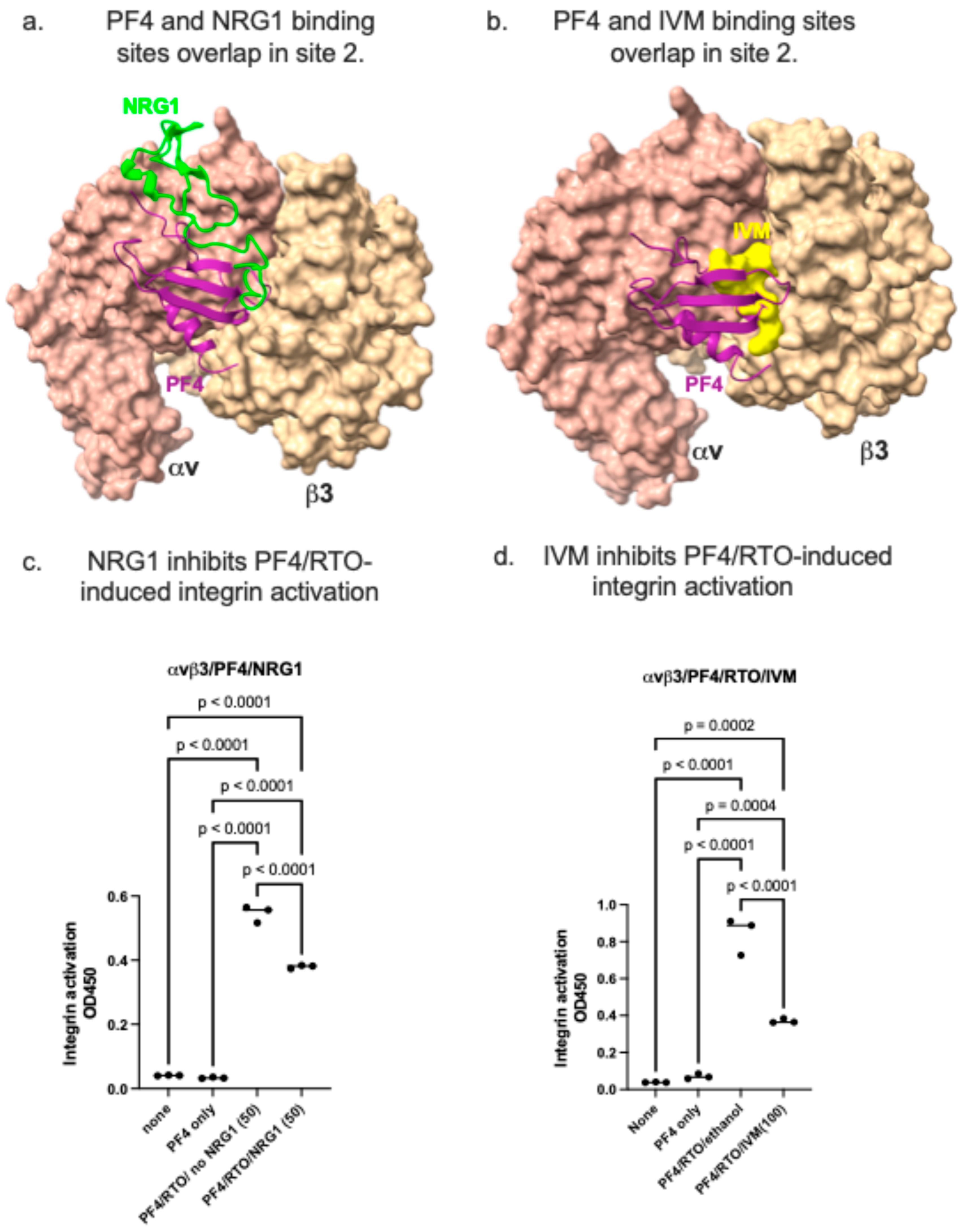PF4 Autoantibody Complexes Cause Activation of Integrins αIIbβ3 and αvβ3 and Possible Subsequent Thrombosis and Autoimmune Diseases
Abstract
1. Introduction
2. Results
2.1. PF4 Specifically Binds to Site 1 and Site 2 of Integrin αvβ3
2.2. PF4 Binds to Site 1 of Activated Soluble Integrins αvβ3 and αIIbβ3

2.3. PF4 Is Predicted to Bind to Site 2 but Did Not Activate Integrins
2.4. Anti-PF4 (RTO) Changes the Phenotype of PF4 from Inhibitory to Activating
2.5. PF4 Mutant Defective in Site 2 Binding Is Defective in Integrin Activation and Acted as an Antagonist for PF4/RTO-Induced Integrin Activation
2.6. Plasma from Healthy Controls Contains Antibodies That Activate Soluble Integrins in a PF4-Dependent Manner but Sera from SLE or RA Patients Did Not
2.7. Ivermectin Inhibits RTO/PF4-Mediated Integrin Activation
3. Discussion
4. Experimental Procedures
4.1. Fibrinogen γ-Chain C-Terminal Residues 390-411, a Specific Ligand for αIIbβ3 Fused to GST
4.2. The Fibrinogen γ-Chain C-Terminal Domain (γC399tr, Residues 151-399)
4.3. PF4
4.4. ELISA-Type Integrin Activation Assays [9]
4.5. ELISA-Type Integrin Binding Assays [3]
4.6. Docking Simulation
4.7. Mass Spec Sequencing
4.8. Other Methods
5. Conclusions
Supplementary Materials
Author Contributions
Funding
Data Availability Statement
Acknowledgments
Conflicts of Interest
References
- Takada, Y.; Ye, X.; Simon, S. The integrins. Genome Biol. 2007, 8, 215. [Google Scholar] [CrossRef]
- Fujita, M.; Takada, Y.K.; Takada, Y. Integrins alphavbeta3 and alpha4beta1 act as coreceptors for fractalkine, and the integrin-binding defective mutant of fractalkine is an antagonist of CX3CR1. J. Immunol. 2012, 189, 5809–5819. [Google Scholar] [CrossRef]
- Fujita, M.; Takada, Y.K.; Takada, Y. The chemokine fractalkine can activate integrins without CX3CR1 through direct binding to a ligand-binding site distinct from the classical RGD-binding site. PLoS ONE 2014, 9, e96372. [Google Scholar] [CrossRef] [PubMed]
- Fujita, M.; Davari, P.; Takada, Y.K.; Takada, Y. Stromal cell-derived factor-1 (CXCL12) activates integrins by direct binding to an allosteric ligand-binding site (site 2) of integrins without CXCR4. Biochem. J. 2018, 475, 723–732. [Google Scholar] [CrossRef] [PubMed]
- Takada, Y.K.; Fujita, M.; Takada, Y. Pro-Inflammatory Chemokines CCL5, CXCL12, and CX3CL1 Bind to and Activate Platelet Integrin alphaIIbbeta3 in an Allosteric Manner. Cells 2022, 11, 3059. [Google Scholar] [CrossRef] [PubMed]
- Takada, Y.K.; Takada, Y. Ivermectin Binds to the Allosteric Site (Site 2) and Inhibits Allosteric Integrin Activation by TNF and Other Pro-Inflammatory Cytokines. Int. J. Mol. Sci. 2025, 26, 8655. [Google Scholar] [CrossRef]
- Pokharel, S.M.; Shil, N.K.; Gc, J.B.; Colburn, Z.T.; Tsai, S.-Y.; Segovia, J.A.; Chang, T.-H.; Bandyopadhyay, S.; Natesan, S.; Jones, J.C.R.; et al. Integrin activation by the lipid molecule 25-hydroxycholesterol induces a proinflammatory response. Nat. Commun. 2019, 10, 1482. [Google Scholar] [CrossRef]
- Takada, Y.K.; Takada, Y. Neuregulin-1 (NRG1) Binds to the Allosteric Binding Site (Site 2) and Suppresses Allosteric Integrin Activation by Inflammatory Cytokines: A Potential Mechanism of Anti-Inflammatory and Anti-Fibrosis Action of NRG1. Cells 2025, 14, 617. [Google Scholar] [CrossRef]
- Takada, Y.K.; Wu, X.; Wei, D.; Hwang, S.; Takada, Y. FGF1 Suppresses Allosteric Activation of beta3 Integrins by FGF2: A Potential Mechanism of Anti-Inflammatory and Anti-Thrombotic Action of FGF1. Biomolecules 2024, 14, 888. [Google Scholar] [CrossRef]
- Aidoudi, S.; Bujakowska, K.; Kieffer, N.; Bikfalvi, A. The CXC-chemokine CXCL4 interacts with integrins implicated in angiogenesis. PLoS ONE 2008, 3, e2657. [Google Scholar] [CrossRef]
- Datta, P.; Zhang, F.; Dordick, J.S.; Linhardt, R.J. Platelet factor 4 polyanion immune complexes: Heparin induced thrombocytopenia and vaccine-induced immune thrombotic thrombocytopenia. Thromb. J. 2021, 19, 66. [Google Scholar] [CrossRef]
- Satoh, T.; Tanaka, Y.; Okazaki, Y.; Kaburaki, J.; Ikeda, Y.; Kuwana, M. Heparin-dependent and -independent anti-platelet factor 4 autoantibodies in patients with systemic lupus erythematosus. Rheumatology 2012, 51, 1721–1728. [Google Scholar] [CrossRef]
- Lishko, V.K.; Yakubenko, V.P.; Ugarova, T.P.; Podolnikova, N.P. Leukocyte integrin Mac-1 (CD11b/CD18, alphaMbeta2, CR3) acts as a functional receptor for platelet factor 4. J. Biol. Chem. 2018, 293, 6869–6882. [Google Scholar] [CrossRef]
- Warkentin, T.E. Platelet-activating anti-PF4 disorders: An overview. Semin. Hematol. 2022, 59, 59–71. [Google Scholar] [CrossRef]
- Levine, S.P.; Wohl, H. Human platelet factor 4: Purification and characterization by affinity chromatography. Purification of human platelet factor 4. J. Biol. Chem. 1976, 251, 324–328. [Google Scholar] [CrossRef]
- Maione, T.E.; Gray, G.S.; Hunt, A.J.; Sharpe, R.J. Inhibition of tumor growth in mice by an analogue of platelet factor 4 that lacks affinity for heparin and retains potent angiostatic activity. Cancer Res. 1991, 51, 2077–2083. [Google Scholar] [PubMed]
- Maione, T.E.; Gray, G.S.; Petro, J.; Hunt, A.J.; Donner, A.L.; Bauer, S.I.; Carson, H.F.; Sharpe, R.J. Inhibition of angiogenesis by recombinant human platelet factor-4 and related peptides. Science 1990, 247, 77–79. [Google Scholar] [CrossRef]
- Maione, T.E.; Sharpe, R.J. Development of angiogenesis inhibitors for clinical applications. Trends Pharmacol. Sci. 1990, 11, 457–461. [Google Scholar] [CrossRef] [PubMed]
- Aidoudi, S.; Bikfalvi, A. Interaction of PF4 (CXCL4) with the vasculature: A role in atherosclerosis and angiogenesis. Thromb. Haemost. 2010, 104, 941–948. [Google Scholar] [CrossRef] [PubMed]
- Zhang, X.-P.; Kamata, T.; Yokoyama, K.; Puzon-McLaughlin, W.; Takada, Y. Specific interaction of the recombinant disintegrin-like domain of MDC-15 (metargidin, ADAM-15) with integrin alphavbeta3. J. Biol. Chem. 1998, 273, 7345–7350. [Google Scholar] [CrossRef] [PubMed]
- Langer, H.; May, A.E.; Bültmann, A.; Gawaz, M. ADAM 15 is an adhesion receptor for platelet GPIIb-IIIa and induces platelet activation. Thromb. Haemost. 2005, 94, 555–561. [Google Scholar] [CrossRef]
- Lande, R.; Mennella, A.; Palazzo, R.; Pietraforte, I.; Stefanantoni, K.; Iannace, N.; Butera, A.; Boirivant, M.; Pica, R.; Conrad, C.; et al. Anti-CXCL4 Antibody Reactivity Is Present in Systemic Sclerosis (SSc) and Correlates with the SSc Type I Interferon Signature. Int. J. Mol. Sci. 2020, 21, 5102. [Google Scholar] [CrossRef]
- Izumi, M.; Sakai, T.; Shirakawa, A.; Kozuru, H.; Jiuchi, Y.; Izumi, Y.; Asahara, T.; Kumagai, K.; Mawatari, M.; Osaki, M.; et al. Reduced induction of anti-PF4/heparin antibody in RA patients after total knee arthroplasty. Arthritis Res. Ther. 2016, 18, 191. [Google Scholar] [CrossRef]
- Arepally, G.M.; Kamei, S.; Park, K.S.; Kamei, K.; Li, Z.Q.; Liu, W.; Siegel, D.L.; Kisiel, W.; Cines, D.B.; Poncz, M. Characterization of a murine monoclonal antibody that mimics heparin-induced thrombocytopenia antibodies. Blood 2000, 95, 1533–1540. [Google Scholar] [CrossRef] [PubMed]
- Yokoyama, K.; Zhang, X.P.; Medved, L.; Takada, Y. Specific binding of integrin alpha v beta 3 to the fibrinogen gamma and alpha E chain C-terminal domains. Biochemistry 1999, 38, 5872–5877. [Google Scholar] [CrossRef] [PubMed]
- Mori, S.; Wu, C.Y.; Yamaji, S.; Saegusa, J.; Shi, B.; Ma, Z.; Kuwabara, Y.; Lam, K.S.; Isseroff, R.R.; Takada, Y.K.; et al. Direct binding of integrin alphavbeta3 to FGF1 plays a role in FGF1 signaling. J. Biol. Chem. 2008, 283, 18066–18075. [Google Scholar] [CrossRef] [PubMed]





| PF4 (1RHP.pdb) | αv (1JV2.pdb) | β3 (1JV2.pdb) |
| Thr15, Thr16, Ser17, Gln18, Val19, Arg20, Pro21, Arg22, His23, Thr25, Lys46, Asn47, Arg49, Asp54, Leu55, Gln56, Ala57, Pro58, Leu59, Lys62, Lys65, Lys66, Leu67, Glu69, Ser70 | Glu15, Gly16, Ser17, Tyr18, Phe19, Lys42, Asn44, Ile50, Val51, Glu52, Trp93, Ala396, Ala397, Arg398, Ser399, Met400, Phe427, Gly428, Val429, Asp430 | Pro160, Met165, Lys235, Gly264, Ile265, Val266, Gln267, Asp270, Gln272, Cys273, His274, Val275, Gly276, Ser277, Asp278, His280, Tyr281, Ser282, Ala283, Thr285, Thr286, Met287 |
Disclaimer/Publisher’s Note: The statements, opinions and data contained in all publications are solely those of the individual author(s) and contributor(s) and not of MDPI and/or the editor(s). MDPI and/or the editor(s) disclaim responsibility for any injury to people or property resulting from any ideas, methods, instructions or products referred to in the content. |
© 2025 by the authors. Licensee MDPI, Basel, Switzerland. This article is an open access article distributed under the terms and conditions of the Creative Commons Attribution (CC BY) license (https://creativecommons.org/licenses/by/4.0/).
Share and Cite
Takada, Y.K.; Wu, C.-Y.; Takada, Y. PF4 Autoantibody Complexes Cause Activation of Integrins αIIbβ3 and αvβ3 and Possible Subsequent Thrombosis and Autoimmune Diseases. Int. J. Mol. Sci. 2025, 26, 10260. https://doi.org/10.3390/ijms262110260
Takada YK, Wu C-Y, Takada Y. PF4 Autoantibody Complexes Cause Activation of Integrins αIIbβ3 and αvβ3 and Possible Subsequent Thrombosis and Autoimmune Diseases. International Journal of Molecular Sciences. 2025; 26(21):10260. https://doi.org/10.3390/ijms262110260
Chicago/Turabian StyleTakada, Yoko K., Chun-Yi Wu, and Yoshikazu Takada. 2025. "PF4 Autoantibody Complexes Cause Activation of Integrins αIIbβ3 and αvβ3 and Possible Subsequent Thrombosis and Autoimmune Diseases" International Journal of Molecular Sciences 26, no. 21: 10260. https://doi.org/10.3390/ijms262110260
APA StyleTakada, Y. K., Wu, C.-Y., & Takada, Y. (2025). PF4 Autoantibody Complexes Cause Activation of Integrins αIIbβ3 and αvβ3 and Possible Subsequent Thrombosis and Autoimmune Diseases. International Journal of Molecular Sciences, 26(21), 10260. https://doi.org/10.3390/ijms262110260







